One of the most frequently asked questions from those joining our winter courses is: What if there is no snow? Although we can’t control the weather, we can almost guarantee there will be snow—especially on the high peaks during winter and early spring. However, for those still concerned, let us put your worries to rest.
The Cairngorms are home to Britain’s most permanent snow beds, some of which persist well into July or even early August. The high altitude and vast plateau of the Cairngorms make them a natural snow trap. Even in milder winters, the unique topography and wind patterns often ensure that snow is captured and retained in key areas. According to a study by the Royal Meteorological Society, the Cairngorm plateau experiences snow coverage for an average of 76 days per year, making it one of the most reliable locations for snow in the UK.
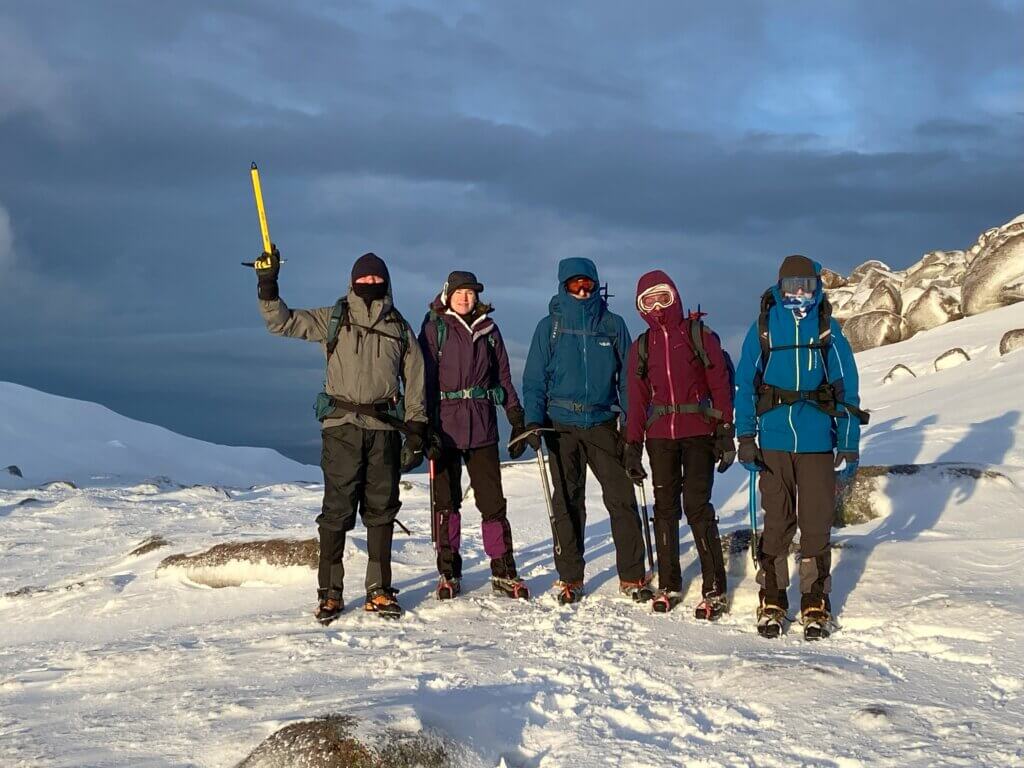
If, for some reason, the winter is unusually mild and snowfall is limited, it’s not the end of the world. Winter Skill courses with Scot Mountain Holidays are designed with flexibility in mind. Snow is just one of three critical factors that influence the course—the other two being wind (which facilitates snow drifting) and the expansive Cairngorm plateau (which helps to capture and hold snow).
Even if snow levels are lower, the skills taught during our courses remain relevant. In fact, hard, icy snow that forms after a thaw and subsequent freeze is often ideal for teaching crampon techniques. Fresh snow, while beautiful, doesn’t always add additional value to winter skills training.
In the 25 winter seasons that Scot Mountain Holidays has been running Winter Skills courses and hiking holidays, no course has ever been cancelled due to a lack of snow. This incredible track record highlights the reliability of the Cairngorms as a winter training destination.
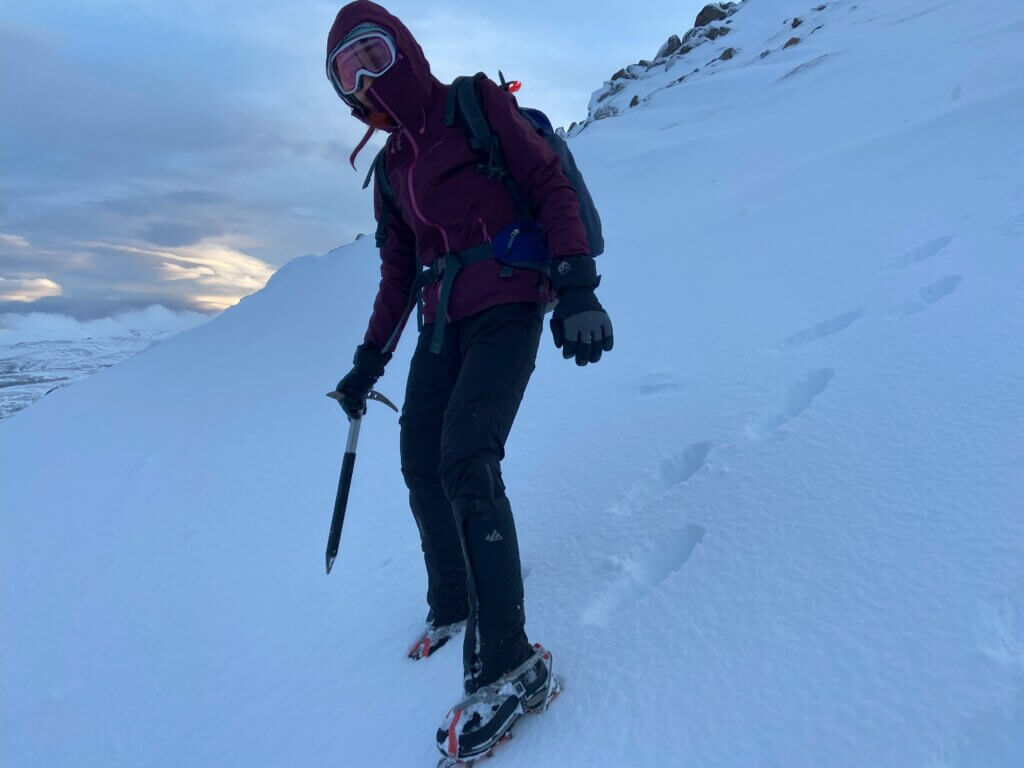
While snow is a strong likelihood on the peaks where our courses take place, there are many other elements that make your experience memorable. Thick, deep snow can sometimes make routes more strenuous. On the other hand, mixed conditions offer a chance to practice a wide variety of essential skills, including:
These skills are just as important, if not more so, than simply walking on deep snow.
Remember, winter skills are about preparing you for all types of conditions you might encounter in the mountains. Snow is a bonus, but not a requirement. The camaraderie, expert instruction, and opportunity to immerse yourself in Scotland’s stunning winter landscape are what truly make Scot Mountain Holidays’ courses unforgettable.
So, whether the snow is thick, patchy, or concentrated in specific areas, rest assured that your Winter Skills course will still be an incredible and valuable experience. The Cairngorms’ rugged beauty, combined with expert guidance, ensures your time with us is both safe and rewarding. As one participant noted, “The course was transformational—I learned so much, regardless of snow levels.”
Join us this winter to develop your confidence and skills in one of the UK’s most dramatic settings. With Scot Mountain Holidays, you’re in expert hands, and no matter the snow conditions, we’ll make sure your time in the Cairngorms is unforgettable.

Scotland is a land of breathtaking beauty, with unique charms that shift with the seasons. While summer often steals the spotlight for visitors, winter remains a hidden gem offering raw beauty, crisp days, and unparalleled hiking experiences. If you’ve been hesitant to venture out during the colder months, let us convince you with five compelling reasons to go hiking in winter and join Scot Mountain Holidays for a trip you’ll never forget.
The peaks of Scotland are awe-inspiring at any time of year, but winter elevates their majesty to a whole new level. Snow-dusted summits, frost-kissed landscapes, and the clarity of winter skies combine to create an otherworldly spectacle. On clear days, the views are nothing short of magical, with the crisp air enhancing visibility and making every vista unforgettable. Scotland’s Cairngorms, for instance, often boast snow-covered peaks that rival the beauty of alpine ranges. Layer up, embrace the brisk wind, and let the beauty of hiking in winter reward your efforts.
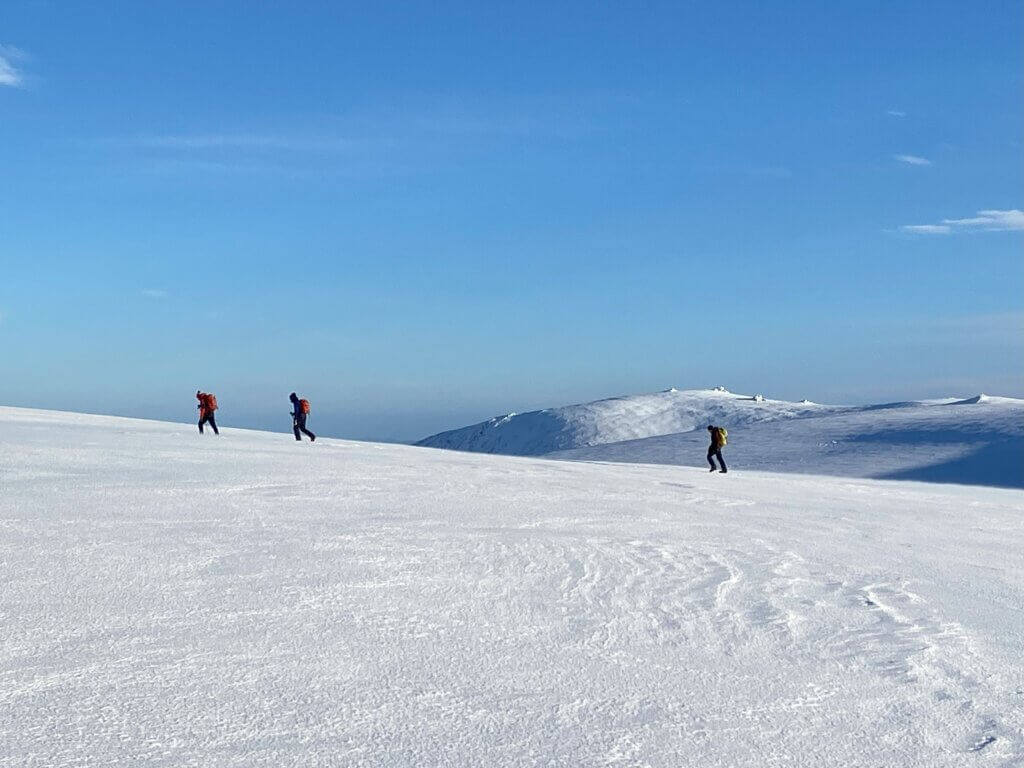
What a view! – New Year Winter Walking 2022 – 2023
The cold temperatures of winter naturally deter many would-be hikers, leaving the trails quieter and more serene. This means fewer crowds and more opportunities to immerse yourself in the solitude of Scotland’s wild spaces. With fewer distractions, you can fully connect with nature, reflect, and appreciate the tranquility of your surroundings. Imagine having iconic trails, like those in the Cairngorms or around Ben Nevis, almost entirely to yourself. It’s an unparalleled chance to experience Scotland’s rugged beauty in its purest form while hiking in winter.
Winter unveils a strikingly different perspective of Scotland’s landscapes. The absence of lush greenery exposes the raw, rugged beauty of the mountains—from dramatic rock formations to stark, snow-covered terrain. If you’re lucky enough to encounter fresh snowfall, the transformation is magical. The pristine white blanket enhances the contours and textures of the land, offering photographers and nature enthusiasts endless inspiration during their winter hikes. Plus, winter often brings incredible sunrises and sunsets that bathe the snow-dusted peaks in hues of gold and pink, perfect for unforgettable photos.

Winter sunset colours glowing on the snow covered Cairngorms
For the fitness-minded adventurer, hiking in winter provides an added bonus: increased calorie burn. The colder temperatures force your body to work harder to stay warm, meaning you’ll burn more calories compared to hiking in warmer weather. Add in the effort of navigating snow-covered paths, and your winter hike becomes an even more rewarding workout. Studies suggest that cold-weather exercise can burn up to 30% more calories, making winter hikes both invigorating and beneficial for your health.
Hiking in winter introduces unique challenges, from navigating icy trails to managing colder temperatures. These added elements demand a different level of preparation and skill, but they also offer an unparalleled sense of achievement. Conquering a winter hike builds confidence and leaves you with stories to share for years to come. Proper preparation—like wearing crampons and layering effectively—can transform these challenges into exciting opportunities to learn new skills. Plus, the sense of adventure and novelty makes every step more exciting.
If you’re ready to challenge yourself, embrace the season, and experience some of the most stunning terrain and views imaginable, hiking in winter in Scotland awaits. With the Cairngorms averaging over 100 days of snow cover per year, it’s one of the best places in the UK to experience a true winter wonderland. Join Scot Mountain Holidays for a guided adventure that will leave you with lasting memories and a newfound appreciation for this extraordinary season.
Setting off on expedition across the snowy Cairngorm plateau
When you think of snow, it’s easy to picture adrenaline-filled days of skiing or snowboarding. But what if you’re not a fan of the slopes or simply want to try something different? Scotland offers a winter wonderland full of thrilling alternatives that let you embrace the snow in unique ways.
Here are Scot Mountain Holidays’ top four snowy adventures for non-skiers, perfect for creating magical winter memories.
Hiking isn’t just a summer activity—winter hiking offers a whole new level of magic. With snow-dusted trails and tranquil, crowd-free paths, it’s the perfect way to experience Scotland’s rugged beauty in its most serene form.
Yes, winter hiking comes with challenges, but the rewards are extraordinary. Picture yourself surrounded by glistening peaks, breathing in crisp mountain air, and savoring the quiet that only snow can bring. Just be sure to bundle up and prepare for the elements!
For those craving adventure with a side of learning, Scot Mountain Holidays offers snow skills courses that are as practical as they are exhilarating.
From mastering ice axes to building emergency snow shelters or navigating icy terrain, these courses give you hands-on experience that’s both empowering and fun. Not only will you leave with stories to tell, but you’ll also pick up life-saving skills that every winter enthusiast should have.
Not every snowy adventure needs to be a grand expedition! Sometimes, the best memories come from simple, joyful moments.
Spend an afternoon building a snowman, crafting the perfect snow angel, or engaging in a good old-fashioned snowball fight. If you’re traveling with kids (or just feeling like one yourself), grab a sled and race down a snowy hill.
End your day by cozying up by a roaring fire with a hot drink and a good book. After all, there’s nothing like the warmth of home after a day of snowy fun.
If you’ve never tried snowshoeing, you’re in for a treat! Imagine strapping on tennis racket-like footwear and gliding effortlessly across snowy trails and frozen terrain. Snowshoeing is easy to learn, beginner-friendly, and a fantastic way to immerse yourself in Scotland’s breathtaking winter scenery. However, the snow conditions on the Scottish hills are not always suitable for snowshoeing which lends itself more to the soft powder snow you find in the Rockies or the Alps. It’s far more common to see winter hikers in Scotland out with crampons and an ice axe, than it is to see a group of snowshoers.
From snow-covered peaks to quiet, magical trails, Scotland is the ultimate destination for winter lovers. With Scot Mountain Holidays, you can enjoy a range of activities designed for adventurers who want to experience the snow without strapping on skis or a snowboard.
So, whether you’re trekking through glistening forests, learning new skills, or simply playing in the snow, Scotland promises a winter escape like no other.
Ready to trade the slopes for something different? Let Scot Mountain Holidays help you craft your perfect snow-filled adventure!

Andy Bateman has instructed and guided for over 25 winter seasons across Scotland. At times its blue skies and a winter wonderland but being based in the Cairngorms he is no stranger to the sometimes uncompromising conditions that can be encountered on Scotland’s high mountains during the winter months.
Putting aside the obvious need to dress properly for the conditions, here are a few of his expert winter skills tips:
Unless your rucksack has a facility specifically for carrying crampons safely on the outside, they should be in a crampon bag inside your rucksack when not on your boots. They are heavy items of kit and can easily work loose when attached with exterior straps or bungee. Crampons carried on the outside can also be a source of injury for other members of the party e.g. in high winds.
The snow and ice conditions can be as varied as the weather that creates them. Don’t limit the techniques at your disposal before you’ve even set foot on the mountain by wearing bendy boots. A key and often overlooked feature of a stiff boot is that it allows you to concentrate your weight on the edges of the sole so you’re able to use them to cut into the snow surface. Your boot is as much a tool as your ice-axe or crampons. B1 “winter” boots are often too flexible to effectively kick steps in hard snow; if you try to front point, the toes tend to bend up and the heel drops causing the wearer to feel unstable. Fully rigid B3 mountaineering boots don’t feel overkill for a winter mountain walk.

Crampons at work
There are a few situations where a long shaft is an advantage but they are outweighed by the number of situations where a short shafted axe is your best bet. Go for an axe with a relatively straight shaft and no longer than 55cm irrespective of your height.
Remember in winter trekking your rucksack will be heavier, plus the extra weight of winter boots and crampons on your feet, the underfoot conditions and having to check the map more frequently all conspire to slow your pace. On top of this there are fewer daylight hours. It’s important that you’re not over ambitious with your route plan to prevent being caught out. Always make sure you have a decent headtorch.
Your rucksack is already heavier with all the necessary gear required by winter. Heavy boots, crampons and underfoot conditions will sap energy and slow you down. Don’t burden yourself further with superfluous kit by considering whether an item is really necessary for the day. At the same time, be sure you have everything you need.
 Full moon Snow-hole Expedition winter gear
Full moon Snow-hole Expedition winter gearEven with an insulated jacket around the tube, once the temperature drops below -3 deg C hydration bladders tend to easily freeze. You are better off with a water bottle in your sack as close to your back as possible to receive a little body heat. Better still take a thermos flask.
There are situations where an ice axe leash is an advantage but there are also a good number of situations where they can be a hazard. Have an arrangement where the leash can be easily added or removed from the head of the axe, i.e. tie a loop in the end of the leash and larks-foot it through the head of the axe. When you aren’t cutting steps or climbing the leash is probably best kept in your rucksack.
Remember, as your core temperature cools your body reduces its circulation to your extremities, like your hands. If you have cold hands, it may well be worth considering putting an extra layer on, as well as warmer gloves. If the body is compensating for a cooling core, to a certain extent, it doesn’t matter how well insulated your hands are, it’s not going to send anymore warm blood to the extremities.
Your body can burn up 40% more calories just by keeping itself warm. Underfoot conditions and heavy gear add to your body’s energy demands. Standing around for more than 10 minutes can mean folks start to get chilled. Schedule-in regular breaks where possible. I find a 10 min break after approximately every 80 min of walking is optimal. You need good judgement and one of the most sensitive organs in your body to a drop in temperature or a lack of energy is your brain. It needs to be well nourished by both.

Striding out to conquer the winter Cairngorms
Why do it? Because this is why it’s worth it.
Looking for an active New Year. Looking for a fresh, invigorating way to end the year and start 2025 on a high note? Our New Year Winter Walking Break from 27th December to 2nd January offers an unforgettable blend of adventure, skill-building, and celebration.
This isn’t your typical New Year experience. Say goodbye to overindulging on the sofa and hello to crisp winter air, stunning Highland landscapes, and the camaraderie of like-minded adventurers. Whether you’re an experienced hiker or a beginner, this trip is a unique opportunity to connect with nature and yourself.

This trip isn’t all about the trails. Your adventure culminates in the lively street party in Grantown-on-Spey, where you’ll ring in the New Year with music, dancing, and fireworks under the starry Highland skies.
This experience is perfect for anyone active who enjoys the mountains and loves the idea of blending adventure with a touch of comfort and community. If you’ve got a passion for the outdoors and want to start 2025 with purpose and excitement, this trip is for you.
The week between Christmas and New Year can feel like a no-man’s-land. Instead of spending it stuck in the same routine, why not embrace something different? Our winter walking break offers the perfect balance of activity, relaxation, and celebration.
Don’t wait too long—spaces are limited, and this trip fills up fast!
📸 Need more inspiration? Check out the trip slideshow below and imagine yourself in the Highlands this New Year.
Start 2025 with an adventure worth remembering. Book your spot today!
Walking comes in many different guises from dog walking to marathon walking. Perhaps then there’s a reason why “hiking” is becoming much more common usage for wild walking, long-distance and mountain walking. Hiking in summer and walking in winter can almost be classed as 2 different sports.
You might be a keen walker. Alternatively you might have started to develop an interest in walking later in life. You might be walking for health reasons or you might be Munro bagging. Whatever the reason, once you turn to hiking in the mountains, sooner or later you might want to extend your season so you can continue to hike all year round. You’ll want to go walking in winter.
Hiking in winter has its own distinct rewards from unending views in crystal, clear air conditions to solitude and glistening fresh snow, unblemished by evidence of other people. There are however also obvious hazards and also some aspects to winter walking/hiking, which you might not have considered.
In Scotland the winter mountains will almost invariably have snow on them for at least part of the winter. We live in hope that the season will be longer and the snow will remain, but this year, 2017, even the most stubborn of snow patches melted away completely. It’s nearly the end of October already and there’s as yet no sign of the white stuff returning. Still if you are considering some winter hiking, make sure you have received some formal training in the skills you need to remain safe in winter conditions. There is nothing more sapping than cold weather.
There are a surprising number of avalanches in Scotland but most of them go un-witnessed and hence unreported. Fortunately we do have a very good avalanche information service, especially in the Cairngorms. Throughout the winter they produce a daily report of the avalanche risk. With formal training and a bit of experience, you can learn to interpret the report so that you pick the safest route for the day.
Making sure you have the proper boots for winter is essential. “Your boot is as much as tool as your crampons and ice axe” is a sentence often repeated by our own Andy Bateman when he is talking to winter novices. You must have stiff boots rated as B2 or above. However, the problem with the boots is that they weigh a lot more than boots you will be used to walking in and they are so much stiffer that they force you to walk in a slightly different gait from usual. Over the course of a couple of days, the difference in the boots can take its toll on you. You legs and feet will feel a lot more tired than they usually do for the same amount of summer walking.
Take care when wearing winter boots. Try to baby your feet a wee bit and if you have the opportunity a little bit of simulation will stand you in good stead, even if people give you funny looks when you clump along the beach promenade or up and down the city streets in monster boots.
Your pack, whether for an expedition or a day walk, is inevitably going to be bigger in winter. Not only will you need more in your lunch, but you’ll also need space for the additional gear: your ice axe, your crampons, thicker, warmer gloves etc. You’ll need to be ready for the extra weight.
TOP TIP: always try to pack your crampons within your pack as if you have them tied to the outside of your pack, you run the risk of losing one or both of them quite easily.
In winter Scotland’s hills become mountains due to the severity of the weather conditions. There are regularly winds over 100 miles an hour in storms and though you might not plan to be out in conditions like that, even experienced mountaineers can get caught out. A friend of ours was once out in the Cairngorms when the weather turned. He and his party ended up almost crawling out as they were getting blown over when they stood up. The wind was even strong enough to take a head torch off one of their heads.
It’s not only the colder weather which helps to burn up more calories. You do have to carry more stuff with you when you go out hiking in winter. The additional weight will help to burn more calories at the end of the day. But always remember, if you put more calories in than you consume you won’t be losing weight. Just heading out for a hike is not a guarantee that you will lose weight – if that is your aim. You need to balance out keeping warm with the number of calories you consume. You don’t want to be cold, but neither do you want to overeat.
How many calories are burned by being cold?
Calories burned in cold weather
Cold air carries less moisture than warm air and therefore produces better visibility. It is warm air streams which bring precipitation. There is some truth to the statement that it is too cold in the arctic to snow.
Fewer people enjoy going out in the cold weather despite the fact that we have amazing gear now which can keep us warm in virtually any conditions. However, this means that those of us who do go out can enjoy a real sense of solitude and space.
There’s nothing better than sharing the story of the day. The warmth of a fire and a cup of tea at the end of the day will be appreciated so much more after being out in cold conditions.
When people come back after a day out in the snow, they almost always have a novel story to share. The risks are greater than in the summer, but then this enhances the benefits too.
If you stop going out in the colder weather, it may be more difficult to get back to your regular hiking than before. The risk of losing your fitness over the winter is greater as you get older. Walking on the treadmill isn’t really an adequate substitute, but if there’s no other choice …
I don’t know why the mountains seem so much more spectacular when covered in snow, but they do. Maybe it’s because they look more pristine. Maybe it’s because if gives them more shape. Whatever the reason, a little snow seems to add some “je ne sais quoi” to the mountain scene.
We specialise in guided walking holidays and walking skills here in Scotland.
If you’d like to leap in to winter at the deep end, why not think about a snow hole expedition: not an igloo, a snow hole; not an emergency shelter but a deliberate night out in a purpose built shelter. Check it out:
Winter has descended upon the Scottish Highlands, the familiar hills evolve into awe-inspiring mountains, blanketed in a pristine coat of snow, setting the stage for a winter hiking experience like no other. The landscape, now a picturesque haven, invites adventurers to traverse its snow-laden trails, discovering a unique blend of tranquility and adventure. However, one must always keep an eye on the ever present dangers inherent in winter.
Winter hiking in the Highlands offers a striking contrast to other seasons. The once-green paths are now transformed into a pristine canvas of white, waiting to be explored. Intrepid hikers, armed with waterproof gear and insulated boots, embark on journeys that unveil the Highlands’ winter charm.
Traversing the snow-covered trails is a sensory delight. The crunch of snow beneath each step echoes through the valleys, and the brisk winter air invigorates the senses. The hills, now adorned with a glistening layer of frost, create a visual spectacle that adds an extra layer of magic to the hiking experience.
Never forget though that you need to be extra prepared before you head out into the winter hills. Our top tips include:
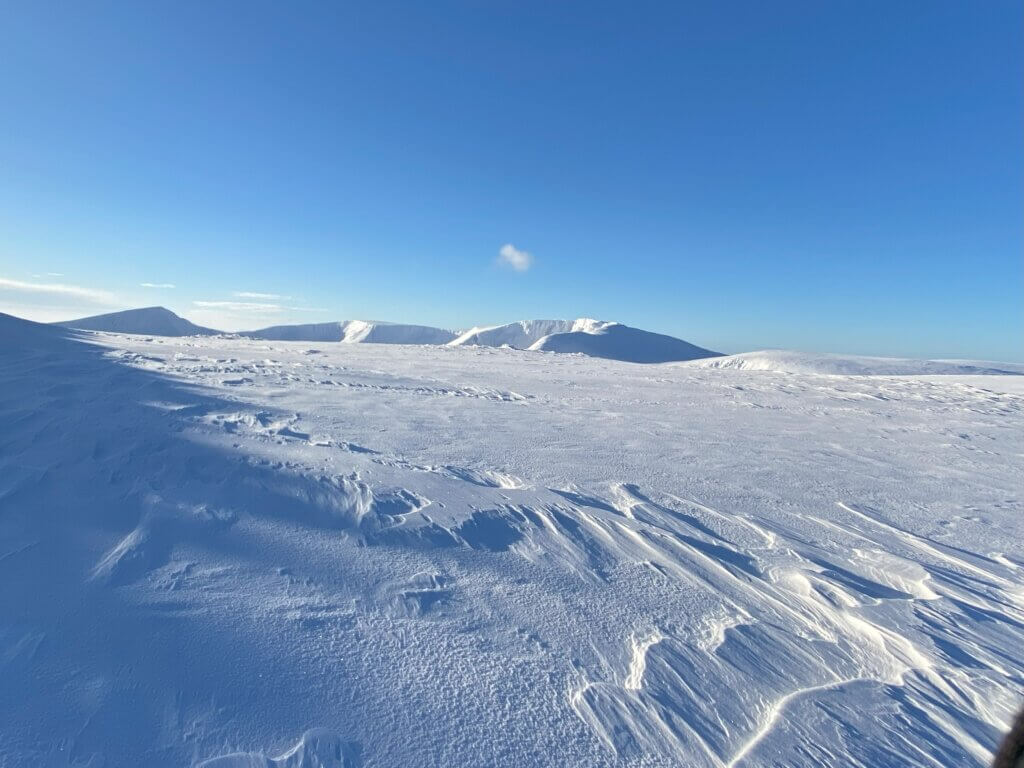
Cairngorm plateau, New Year Winter Walking 2022 – 2023
Preparation is key for those eager to embrace the winter landscape. Layered clothing, including waterproof jackets and insulated gloves, become essential companions (see our blog). As the landscape transitions from hills to mountains, the weather can be unpredictable, and hikers must be equipped to face the challenges that come with the season.
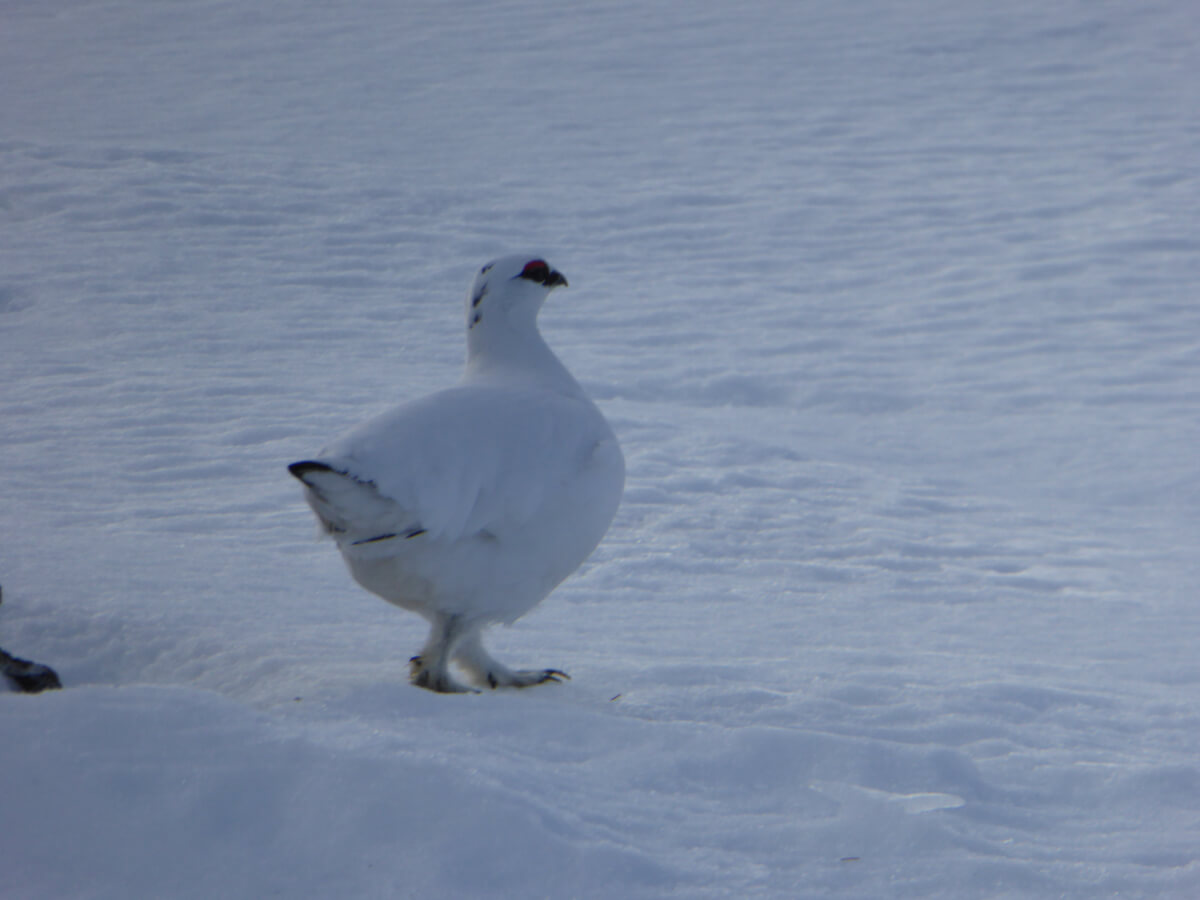
A ptarmigan makes walking across the snow look easy
Popular winter hiking routes in the Highlands include the West Highland Way, the Great Glen Way and the Speyside Way; which transform into a winter wonderland, offering panoramic views of snow-capped peaks and frozen lochs. The Cairngorms National Park, with its diverse trails, provides opportunities to witness the Highland wildlife amidst the winter spectacle; and for the intrepid this area can become a wilderness for the most intrepid to explore and indulge in winter sports and adventures like snow holing.
Hiking in the Highlands during winter is not just a physical adventure but also a journey into solitude and reflection. The silent majesty of the snow-covered landscape imparts a sense of serenity, inviting hikers to connect with nature on a deeper level.
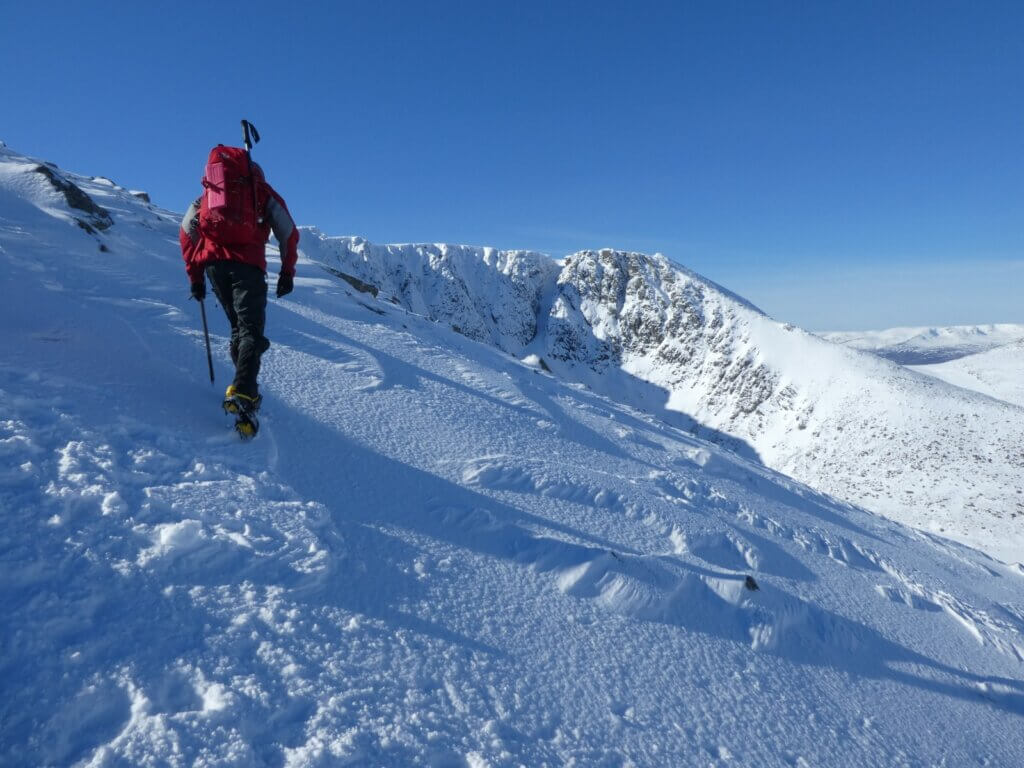
Cozy hostels nestled along the trails and in the villages close by offer refuge after a day of winter exploration. Hostels provide a welcoming retreat where hikers can share stories and relish in the hearty warmth of local hospitality.
Winter hiking in the Highlands of Scotland is a testament to the enduring spirit of nature. It is an invitation to witness the marriage of untamed beauty and the thrill of adventure. So, lace up your boots, embrace the chill, and discover the enchanting transformation that occurs when the hills become mountains in the heart of a Highland winter.
Check out our range of guided winter walking holidays

Everyone loves an open fire, almost as much entertainment as the TV
Every year there are reports of people getting lost in the snow and ice of winter. Mountain rescue callouts are predominantly about navigation errors. To make winter a safer place, it is a good idea to book a guide to lead or alternatively join a group heading out into the hills. Some groups are organised by companies on commercial trips, others are groups of friends or clubs. Nonetheless there is safety in numbers.
Every year there are winter wilderness expeditions running under the guidance of Andy Bateman of Scot Mountain Holidays in the Cairngorms and Glen Affric. There’s also usually a trip to Knoydart, home to Britain’s most remote pub; however there is a major reforestation project going on there this year which makes it less attractive to visit and all the accommodation will be taken by the forestry workers.
Life will be reduced to basics during the expedition and the only concerns will be: eat – sleep – hike (repeat). The perfect way to clear the mind and return feeling completely refreshed after only a few short days.
This is a rare opportunity to experience one of the remotest parts of the Cairngorms National Park at a time when the mountains are probably at their most glorious. The High Cairngorms are renowned for their wintry conditions yet at this time very few folk dare to do multi-day trips

Celia enjoying her second (or third) winter expedition with Scot Mountain Holiadays
Highlights: winter skills, Monadh Mhor (Munro), Devil’s Point (Munro) Carn a’ Mhaim (Munro), Derry Cairngorm (Munro), Beinn a’ Chaorainn (Munro)
Price: £ on application
Email: SCO@scotmountainholidays.com for full information about this trip.
MINIMUM GROUP SIZE: 3 PEOPLE – Private dates available. Please enquire.
This is Scotland’s ultimate winter mountain journey. The high “plateau” route takes in Britain’s 2nd, 3rd, 4th and 5th highest peaks on a journey that circumnavigates Scotland’s finest and best known mountain pass, the Lairig Ghru.
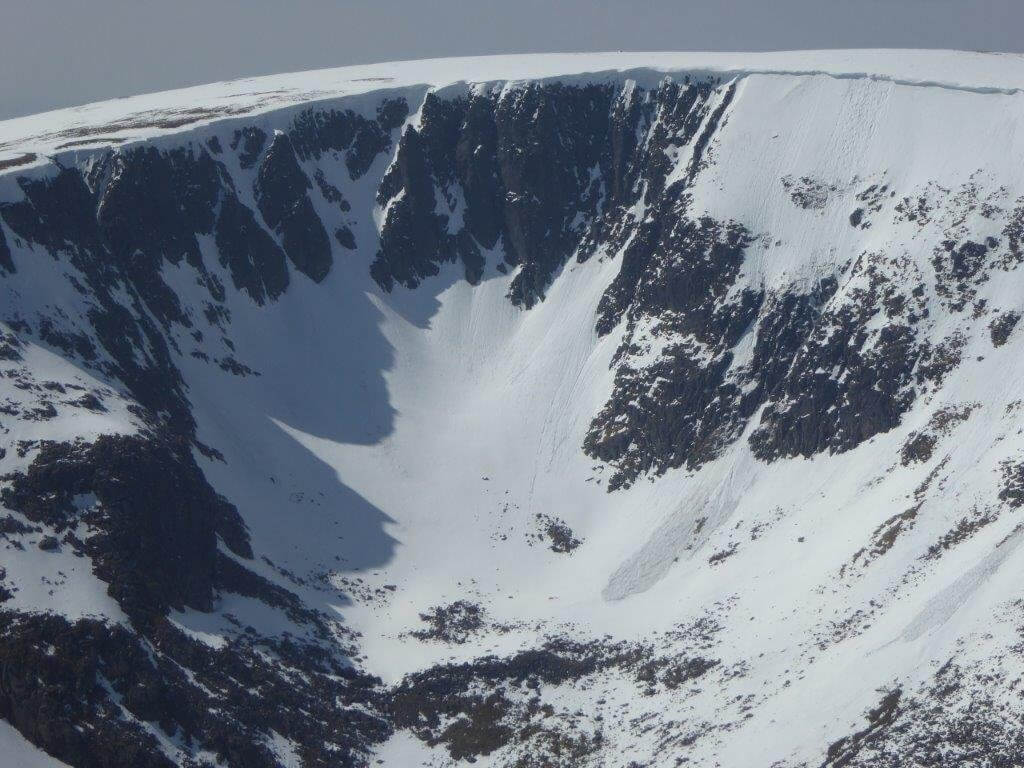
Check out the potential avalanche sites on the head wall. You can see how the corrie came to be made
Highlights: winter skills, Cairngorm (6th Highest Munro), Ben Macdui (2nd Highest Munro), Braeriach (3rd Highest Munro), Cairn Toul (4th Highest Munro), Sgor an Lochain Uaine (Munro)
Price: £ on application
Email: CWO@scotmountainholidays.com for full information about this trip
MINIMUM GROUP SIZE: 3 PEOPLE – Private dates available. Please enquire.
Imagine the soft orange light of a winters dawn gleaming down from the snowy celestial heights. Surrounded by snowy peaks and cradling a mug of tea in the crisp air, indeed a stunning winter’s day beckons.
Highlights: winter skills, Mullach Fraoch – choire (Munro), Mam Sodhail (Munro), Carn Eighe (Munro), An Socach (Munro), Carn a’Choire Ghairbh (Munro)

Spotting deer in Glen Affric while on winter expedition in Scotland
Price: £ on application
Email: Shangri-La@scotmountainholidays.com for full information about this trip
MINIMUM GROUP SIZE: 3 PEOPLE – Private dates available. Please enquire.
Or for something slightly different
“Porridge with whisky at 9am whilst warm & dry in my sleeping bag has never tasted better!” Ric Taylor,Bristol.”
Have you ever dreamt of taking a short walk amongst a moonlit snowy wonderland. Amazingly no need for a torch! Imagine reflected flickering candle light giving way to the soft light of a winters dawn as you emerge from you snowy abode. Not a soul about! We’ll have a vast pristine winter wonderland all to ourselves. It’s a remarkable experience.
Highlights: winter skills on Cairngorm, overnight expedition to sleep in a snow cave, creation of said snow cave

how to build a snowhole in Scotland
All digging and cooking equipment supplied by your hosts, Scot Mountain Holidays.
Check full details on the website
Highlights:
Accommodation: Barrisdale Stable (if available) or heated Tentipi
MINIMUM GROUP SIZE: 3 PEOPLE – Private dates available. Please enquire.
Highlights:
Accommodation: Barrisdale Stable (if available) or heated Tentipi
MINIMUM GROUP SIZE: 3 PEOPLE – Private dates available. Please enquire.
It’s all in vogue these days. As our normal lives become more and more sedentary, there’s an increasing emphasis on keeping fit. As we get older too, it becomes increasing difficult to maintain our fitness levels. We can’t afford to hibernate over the winter. Instead of heading abroad, we can take on a new experience and continue getting out in the countryside throughout the winter months. If you find the winter weather a challenge or too scary, take a course to give you the confidence to get out walking the hills in winter.
Extra ways of burning calories while walking in winter include:
All of which you can tick when you go hillwalking in winter.
As far as anyone can tell, the “one pound on your feet equals five pounds on your back” notion originated with Sir Edmund Hillary’s successful ascent of Mount Everest in 1953. Since then, numerous studies by academic researchers and even the U.S. Army have concluded one thing on the matter: Weight on the feet is disproportionately more exhausting than weight carried on the torso.* To find out more read the links in our further reading section. Therefore walking in winter boots requires more effort and will burn more calories!
The air in winter is so much more crisp and clear than in the spring/summer months. In spring the large estates who own huge swathes of the Scottish hillside, often start to burn the heather to maintain the grouse moors. Obviously this produces a haze from the smoke which can affect visibility. In the summer the air is generally more hazy due to the humidity which then affects how far you are able to see clearly.
In the middle of winter it is possible to see 100km or more from the high hills. For example, Ben Nevis can clearly be seen from the summit of Cairngorm.
Challenge is the big buzz word these days. Have you run your first marathon? Have you participated in your first triathlon/ironman? Tough Mudder anyone? Compared with challenges like these, winter hill walking is much more accessible and something you could do every day (in season). The biggest challenge for winter hillwalking is building up your stamina when you’re also trying to hold down a full time job. Many of us have deskbound jobs these days and the closer we get to “middle-age” (our 40s and 50s) the more difficult it is to maintain fitness and stamina levels. However, in the course of a week, many people find that their fitness and stamina levels noticeably improve on a guided winter hill walking trip.
On a typical winter walking day out with Andy, the guests record steps in excess of 30,000 per day! You’d be well on your way to your #Walk1000miles at that rate.
Sharing is a major part of walking. People tend to chat as they walk in a group and often end up discussing all manner of topics; setting the world to rights. When you share an interest (i.e. walking) already with the people you’re with, chances are you have topics in common you can discuss without coming to blows. Of course, camaraderie is not something which is confined to winter, but there is something about pitting your skills against the environment which pulls your group together and gives you something to share.
It doesn’t matter what sport you’re enthusiastic about, people love to talk about their gear and share their experiences of using it. When it comes to winter walking, if you’re a novice, you will need to make some investments to upgrade from your summer/autumn walking equipment in order to be safe in the winter hills. If you’re not sure it’s going to be your thing (though if you already enjoy walking, you might get hooked quite easily), you can always hire the technical stuff – winter grade boots, ice axe and crampons, before making the leap yourself into buying the kit.
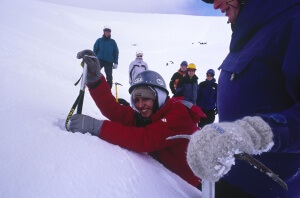 Ice axe arrest on a winter skills course
Ice axe arrest on a winter skills courseSliding around in the snow with a sharp tool – sliding down a hill on your bum – digging in the snow – kicking into ice with crampons – all become legitimate “skills” when you’re on a winter course learning the “personal safety skills” of safe movement on the winter hills.
To go out walking you don’t need to pay for a lift pass for every day you want to go up the hills.
You don’t need to buy the skis and generally you’re further away from the ski lodges, so you don’t have access to the cafes and restaurants, which means you have far fewer opportunities to spend your hard earned pennies.
Gaining new skills and becoming proficient in using them builds confidence not only in the activity you are doing, but also in other areas of your life. It is always a good idea to keep your brain active and to learn new things, particularly if you are also learning new physical skills which will help your body remain fit as well as your brain.
If you’re a novice or if you’re lacking time to gain the skills yourself, remember that winter is harsh environment and not everyone has the experience to head up into the mountains but there are plenty of local, highly-qualified guides who are very happy to take you out.
It’s much more fun to share unusual experiences with your friends. Most people like to see images and videos of adventurous activities, spectacular views, mountains, nature – you can tick all these boxes when you record your experiences out and about in the winter hills, then share then on your favourite social media channel. You’re virtually guaranteed some interaction with your friends/followers.
*A pound on the foot – the science
The Great Outdoor Forum (Stack Exchange) – discussion on the science behind extra weight on your feet.
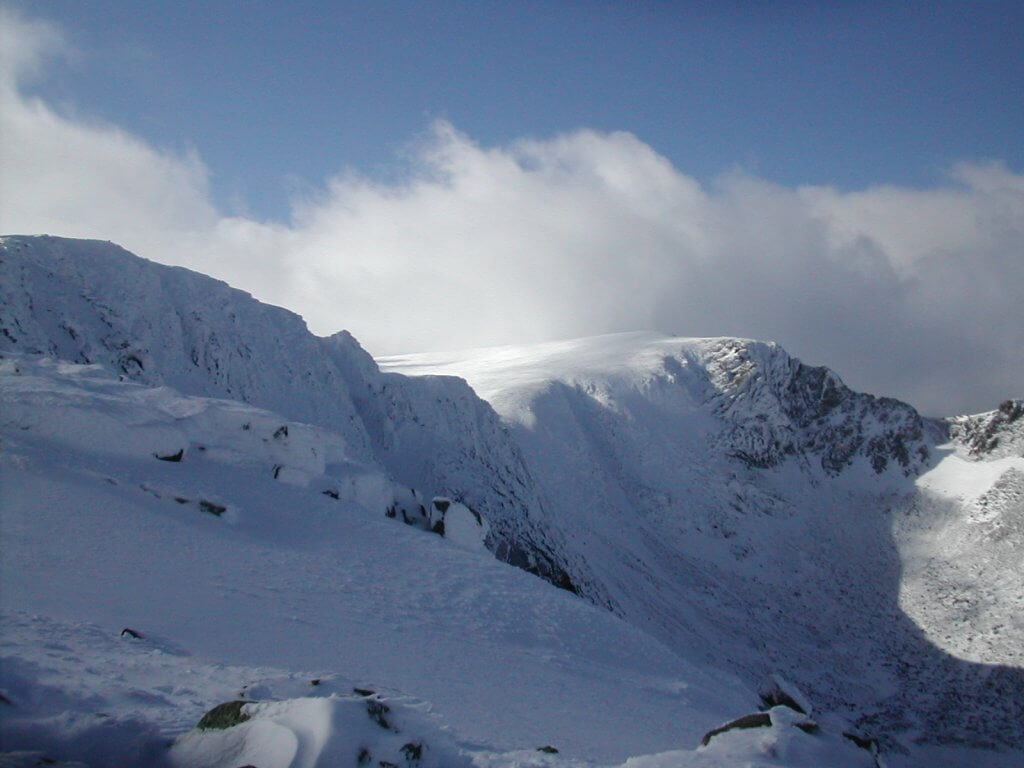
The northern corries of the Cairngorms in their winter garb
A guy headed up into the Cairngorms to go winter climbing. He slipped awkwardly and broke his leg. Fortunately he had his mobile phone with him. He rang mountain rescue, who ascertained that he had all the right gear with him and he know where he was; the forecast was good but they were unable to reach him at that time and would send the helicopter in the morning.
Unbeknownst to the climber, just over the brow of the hill, out of his line of sight, was another guy who planned to camp out over night. Each was unaware of the other. The camper woke up in the morning feeling a wee bitty cold so he decided to cook himself some toast over his camping stove.
As he was eating his toast he heard the unmistakable sound of the rescue helicopter. He watched the winchman descend and pick up the stranded climber and thought: “Oh dear, there must have been someone out there all night.” However, he didn’t really think much more about it.
The climber however, was very thankful that he’d been found at last. He said to the winchman: “Thank God you came to get me. I was beginning to hallucinate. I thought I could smell toast.”
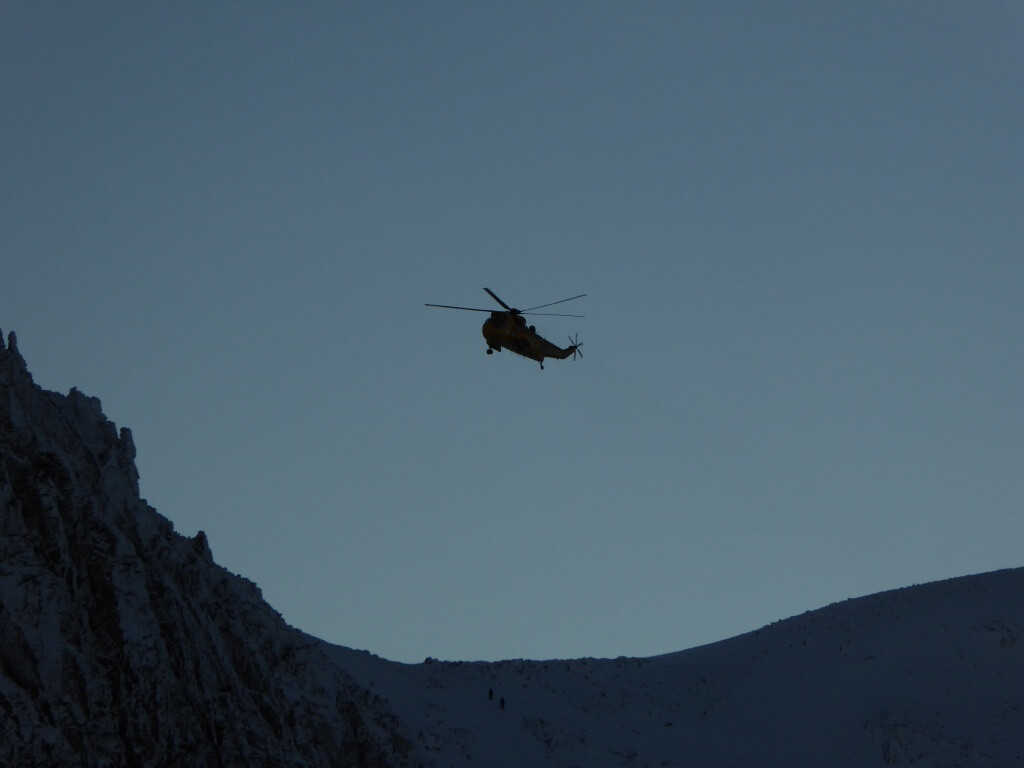
Yellow Whirlie Bird in action in the Cairngorms
If you’re interested in more images from the Cairngorms, from year round visits into the mountains, try our Instagram account
For more news and stories follow us on Facebook
Be safe and be prepared when heading out in the hills at any time of year, especially winter.
If you are looking for some help refreshing your skills for winter, please don’t hesitate to contact us
1. The most amazing snow hole group
2. Why do we call it Hogmanay?
4. Why come to Scotland in winter?
5. How to prepare for a winter skills course?
All content © Copyright Scot Mountain Holidays 2025
Responsive web design by Summit Web Solutions